ECU Acura RSX 2005 Owner's Guide
[x] Cancel search | Manufacturer: ACURA, Model Year: 2005, Model line: RSX, Model: Acura RSX 2005Pages: 243, PDF Size: 3.42 MB
Page 125 of 243
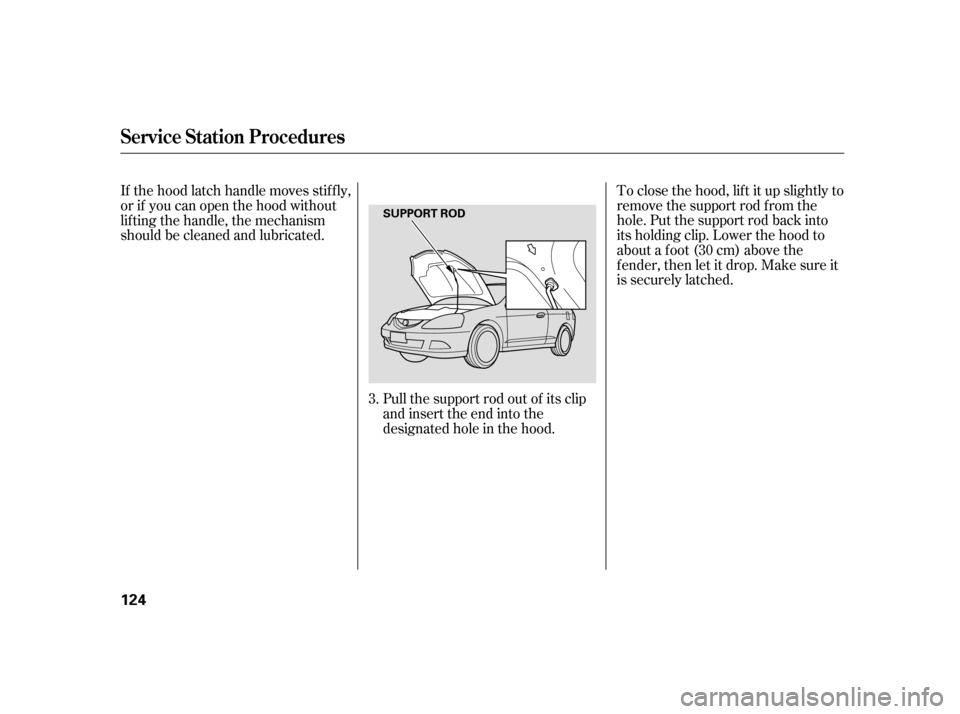
Pull the support rod out of its clip
and insert the end into the
designated hole in the hood.To close the hood, lif t it up slightly to
remove the support rod f rom the
hole. Put the support rod back into
its holding clip. Lower the hood to
about a f oot (30 cm) above the
f ender, then let it drop. Make sure it
is securely latched.
If the hood latch handle moves stif f ly,
or if you can open the hood without
lif ting the handle, the mechanism
should be cleaned and lubricated.
3.
Service Station Procedures
124
SUPPORT ROD
Page 132 of 243

Store or secure all items that could
be thrown around and hurt
someone during a crash.
Be sure items placed on the f loor
behind the f ront seats cannot roll
under the seats and interf ere with
the pedals or seat operation.Distribute cargo evenly on the
f loor of the cargo area, placing the
heaviest items on the bottom and
as far forward as possible.
If youfolddownthebackseat,tie
down items that could be thrown
about the vehicle during a crash or
sudden stop.
Do not place items on the cargo
area cover, or stack objects higher
than the top of the back seat. They
could block your view and be
thrown about the vehicle during a
crash or sudden stop.If you carry large items that
prevent you f rom closing the
hatch, exhaust gas can enter the
passenger area. To avoid the
possibility of
, f ollow the instructions
on page .
Keep the glove box closed while
driving. If it is open, a passenger
could injure their knees during a
crash or sudden stop. If you can carry any items on a
roof rack,besurethetotalweight
of the rack and the items does not
exceed the maximum allowable
weight. Please contact your dealer
for further information.45
Carrying Items in the Passenger
Compartment
carbon monoxide
poisoning
Carrying Cargo in the Cargo A rea
or on a Roof Rack
Carrying Cargo
Bef ore Driving
131
Page 135 of 243
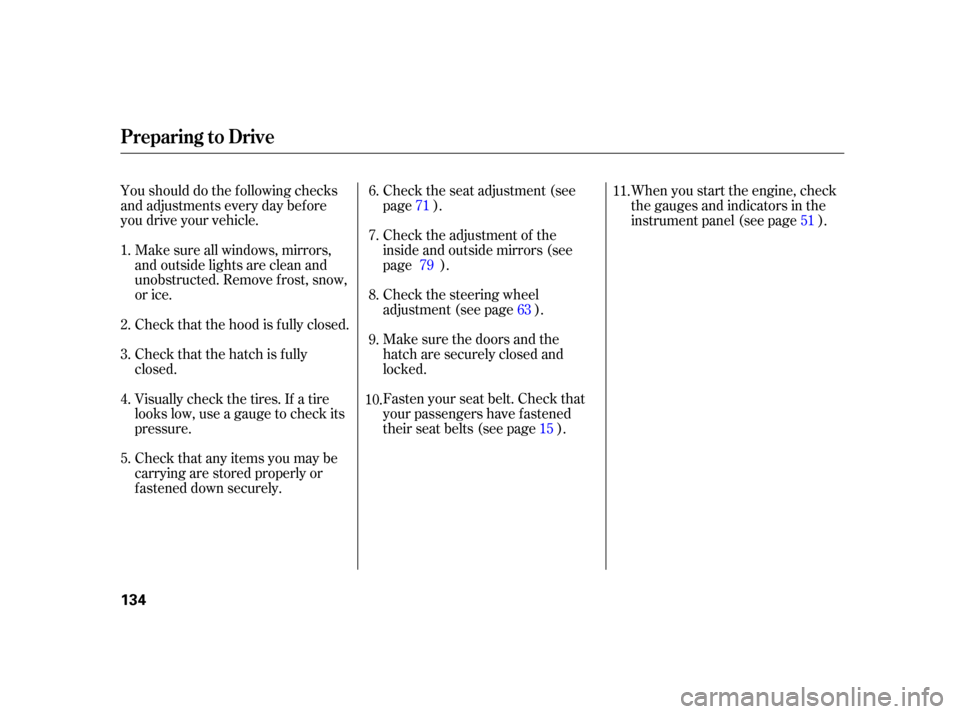
Youshoulddothefollowingchecks
and adjustments every day bef ore
you drive your vehicle.Make sure all windows, mirrors,
and outside lights are clean and
unobstructed. Remove f rost, snow,
or ice. Check the seat adjustment (see
page ).
Check the adjustment of the
inside and outside mirrors (see
page ).
Check the steering wheel
adjustment (see page ).
Make sure the doors and the
hatch are securely closed and
locked.When you start the engine, check
the gauges and indicators in the
instrument panel (see page ).
Check that the hood is f ully closed. Fasten your seat belt. Check that
your passengers have f astened
their seat belts (see page ).
Check that the hatch is f ully
closed.
Check that any items you may be
carrying are stored properly or
f astened down securely. Visually check the tires. If a tire
looks low, use a gauge to check its
pressure.
1.
2.
3.
9. 8. 7. 6.
5. 4. 10. 11.
71
79 63
15 51
Preparing to Drive
134
Page 151 of 243

Your vehicle has a trailer lighting
connector located behind the right
side panel in the cargo area. Ref er to
thedrawingaboveforthewiring
color code and purpose of each pin. If you use a converter, you can get
the connector and pins that mate
with the connector in your vehicle
f rom your dealer.
Always use saf ety chains when you
tow a trailer. Make sure the chains
are secured to the trailer and hitch,
and that they cross under the tongue
and can catch the trailer if it
becomes unhitched. Leave enough
slack to allow the trailer to turn
corners easily, but do not let the
chains drag on the ground.
If you choose electric brakes, be
sure they are electrically actuated.
Do not attempt to tap into your
vehicle’s hydraulic system. No
matter how successf ul it may seem,
any attempt to attach trailer brakes
to your vehicle’s hydraulic system
will lower braking ef f ectiveness and
create a potential hazard. Acura recommends that any trailer
having a total weight of 1,000 lbs
(450 kg) or more be equipped with
its own electric or surge-type brakes.
Towing a Trailer
T railer L ights
Saf et y Chains
Trailer Brakes
150
TAILLIGHT
(RED/YELLOW) LEFT TURN SIGNAL
(GREEN/RED)RIGHT TURN SIGNAL
(GREEN/YELLOW)
GROUND
(BLACK)
BACK UP LIGHT
(GREEN)
BRAKE LIGHT
(WHITE/BLACK)
Page 152 of 243

Many states and Canadian provinces
require special outside mirrors when
towing a trailer. Even if they don’t,
you should install special mirrors if
you cannot clearly see behind you, or
if the trailer creates a blind spot.
Askyourtrailersalesorrental
agency if any other items are
recommended or required f or your
towing situation.The added weight, length, and
height of a trailer will af f ect your
vehicle’s handling and perf ormance,
so driving with a trailer requires
some special driving skills and
techniques.
Foryoursafetyandthesafetyof
others, take time to practice driving
maneuvers bef ore heading f or the
open road, and f ollow the guidelines
discussed below.
Driveslowerthannormalinall
driving situations, and obey posted
speed limits f or vehicles with trailers.
If you have an automatic
transmission, use D position when
towing a trailer on level roads.
When preparing to tow, and bef ore
driving away, be sure to check the
f ollowing:
The vehicle has been properly
serviced, and the tires, brakes,
suspension, cooling system, and
lights are in good operating
condition.
All weights and loads are within
limits.
Thehitch,safetychains,andany
other attachments are secure.
All items in or on the trailer are
properly secured and cannot shif t
while you drive.
Your vehicle tires and spare are
properly inf lated, and the trailer
tires and spare are inflated as
recommended by the trailer
maker.
CONT INUED
Towing a Trailer
A ddit ional T owing Equipment
T owing Speeds and GearsDriving Saf ely With a T railer
Pre-T ow Checklist
Driving
151
Page 163 of 243
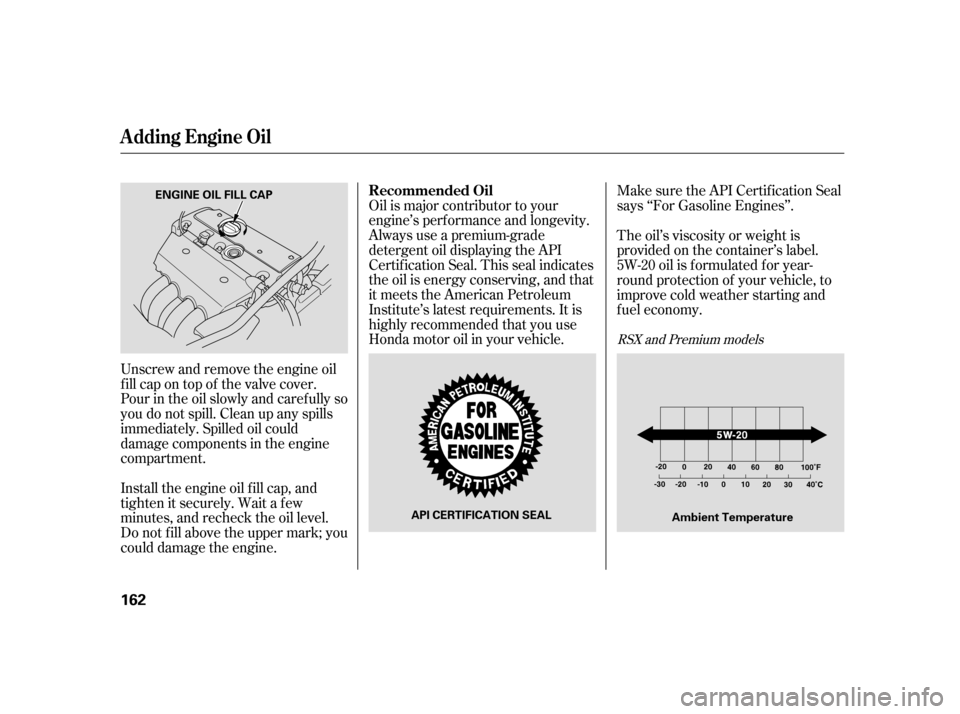
Make sure the API Certif ication Seal
says ‘‘For Gasoline Engines’’.
Oil is major contributor to your
engine’s perf ormance and longevity.
Always use a premium-grade
detergent oil displaying the API
Certif ication Seal. This seal indicates
the oil is energy conserving, and that
it meets the American Petroleum
Institute’s latest requirements. It is
highly recommended that you use
Honda motor oil in your vehicle.
Unscrew and remove the engine oil
fill cap on top of the valve cover.
Pour in the oil slowly and caref ully so
you do not spill. Clean up any spills
immediately. Spilled oil could
damage components in the engine
compartment.
Install the engine oil f ill cap, and
tighten it securely. Wait a f ew
minutes, and recheck the oil level.
Do not f ill above the upper mark; you
could damage the engine. The oil’s viscosity or weight is
provided on the container’s label.
5W-20 oil is f ormulated f or year-
round protection of your vehicle, to
improve cold weather starting and
f uel economy.
RSX and Premium models
A dding Engine Oil
Recommended Oil
162
ENGINE OIL FILL CAP
API CERTIFICATION SEAL Ambient Temperature
Page 169 of 243
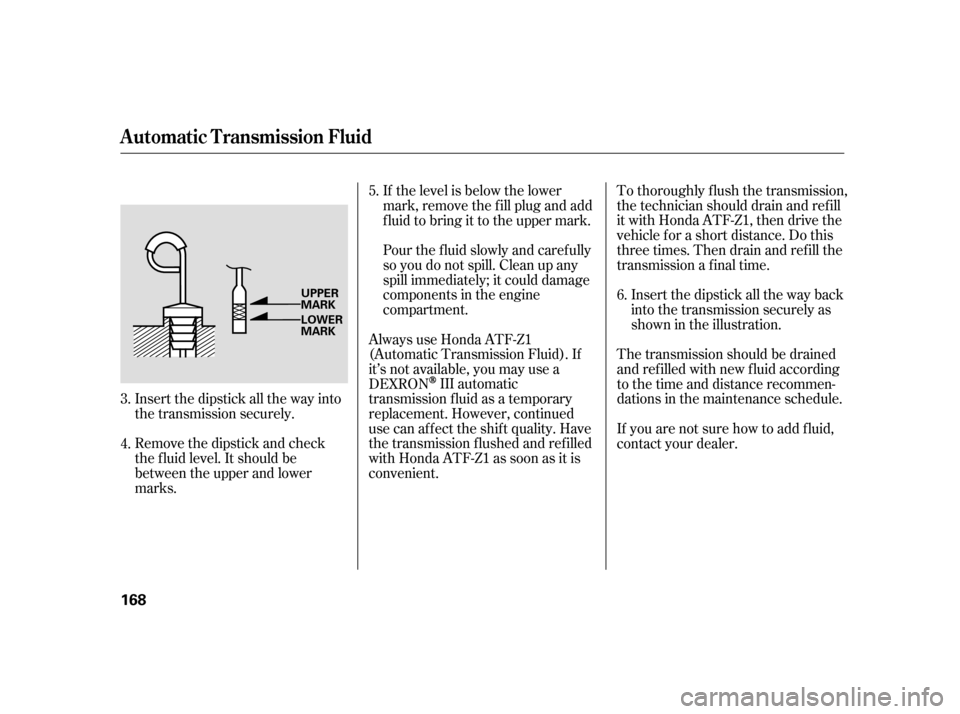
To thoroughly f lush the transmission,
the technician should drain and ref ill
it with Honda ATF-Z1, then drive the
vehicle f or a short distance. Do this
three times. Then drain and ref ill the
transmission a f inal time.Insert the dipstick all the way back
into the transmission securely as
shown in the illustration.
The transmission should be drained
and ref illed with new f luid according
to the time and distance recommen-
dations in the maintenance schedule.
If youarenotsurehowtoaddfluid,
contact your dealer.
If the level is below the lower
mark, remove the f ill plug and add
f luid to bring it to the upper mark.
Pour the f luid slowly and caref ully
so you do not spill. Clean up any
spill immediately; it could damage
components in the engine
compartment.
Always use Honda ATF-Z1
(Automatic Transmission Fluid). If
it’s not available, you may use a
DEXRON
III automatic
transmission f luid as a temporary
replacement. However, continued
use can affect the shift quality. Have
the transmission f lushed and ref illed
with Honda ATF-Z1 as soon as it is
convenient.
Insert the dipstick all the way into
the transmission securely.
Remove the dipstick and check
the f luid level. It should be
between the upper and lower
marks. 6.
5.
3.
4.
Automatic Transmission Fluid
168
UPPER
MARK
LOWER
MARK
Page 174 of 243

Insert the new bulb into the hole,
making sure the tabs are in their
slots. Pivot the hold-down wire
back in place, and clip the end into
the slot.
Install the rubber seal and make
sure it is right side up; it is marked
‘‘TOP.’’
Pull the battery back to its original
position, then install the bolt in the
hold-down, and tighten it securely. Push the electrical connector onto
the tabs of the new bulb. Make
sureitlocksinplace.Turnonthe
headlights to test the new bulb.
Install the neck of the windshield
washer reservoir on the bracket.
Then remove the bolt f rom the
battery hold-down, and caref ully
push the battery toward the
windshield to obtain enough
working space.
Unclip the end of the hold-down
wire f rom its slot. Pivot it out of
the way, and remove the bulb. Remove the rubber weather seal
by pulling on the tab. Remove the electrical connector
f rom the bulb by pulling the
connector straight back.
3.
4. 5.
6.
7.
8.
2.
Lights
Driver’s Side
Maint enance
173
HOLD DOWN
WIRE
BULB
WEATHER SEAL
CONNECTOR
Page 197 of 243
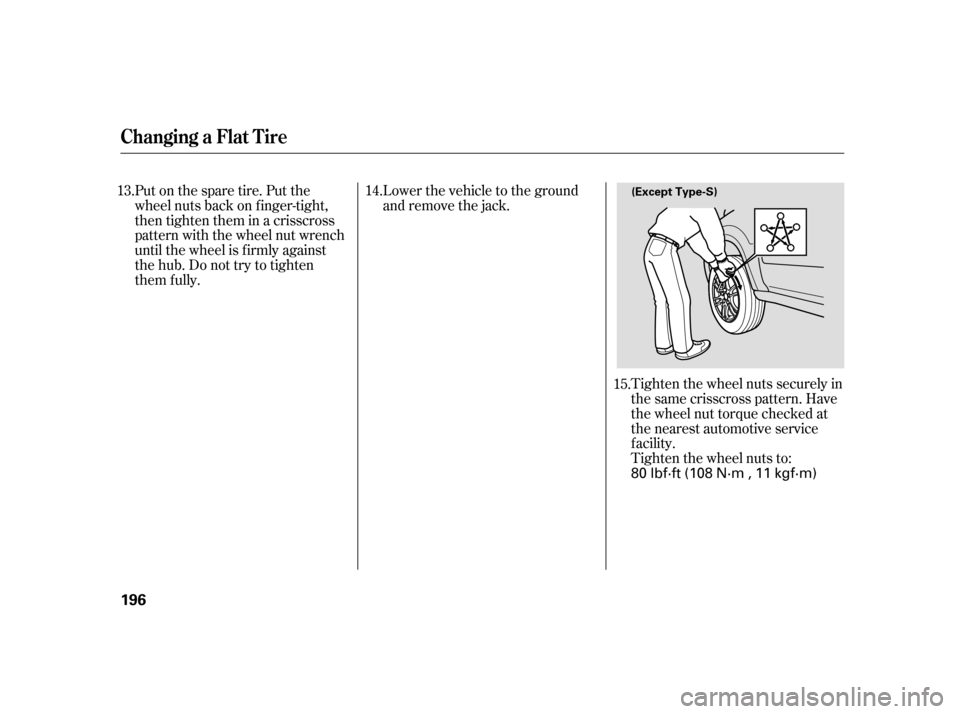
Tighten the wheel nuts securely in
the same crisscross pattern. Have
the wheel nut torque checked at
the nearest automotive service
f acility.
Tighten the wheel nuts to:
Put on the spare tire. Put the
wheel nuts back on f inger-tight,
then tighten them in a crisscross
pattern with the wheel nut wrench
until the wheel is f irmly against
the hub. Do not try to tighten
them f ully.
Lower the vehicle to the ground
and remove the jack.
15.
13.
14.
Changing a Flat T ire
196
(Except Type-S)
80 lbf·ft (108 N·m , 11 kgf·m)
Page 198 of 243
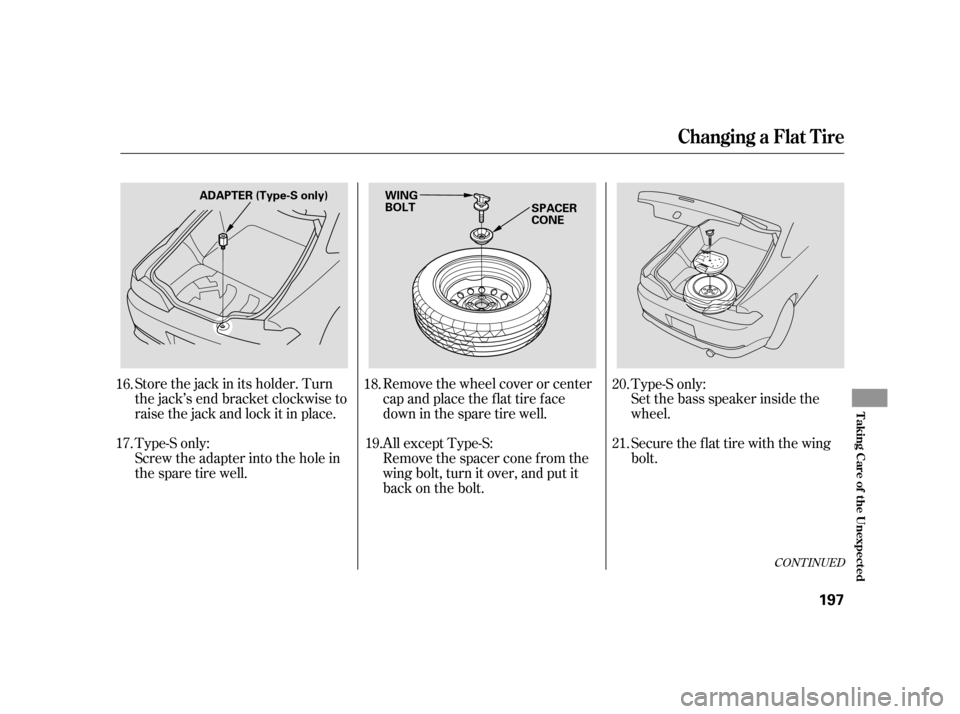
Store the jack in its holder. Turn
the jack’s end bracket clockwise to
raisethejackandlockitinplace.
Screw the adapter into the hole in
the spare tire well.Remove the wheel cover or center
cap and place the flat tire face
down in the spare tire well.
Set the bass speaker inside the
wheel.
Secure the f lat tire with the wing
bolt.
Remove the spacer cone f rom the
wing bolt, turn it over, and put it
back on the bolt.
18.
16.
17. 20.
21.
Type-S only: Type-S only:
19.All except Type-S:
CONT INUED
Changing a Flat T ire
T aking Care of t he Unexpect ed
197
ADAPTER (Type-S only) WING BOLTSPACER
CONE